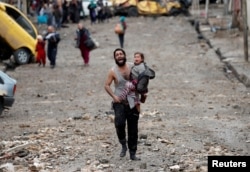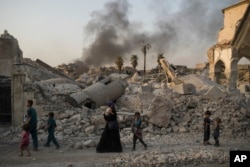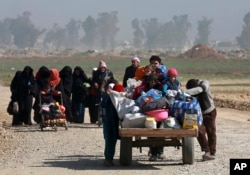Between 9,000 and 11,000 people were killed in the nine-month battle to liberate the Iraqi city of Mosul from the Islamic State group, a civilian casualty rate nearly 10 times higher than has been previously reported, an Associated Press investigation found.
The deaths aren't acknowledged by the U.S.-led coalition, the Iraqi government or IS's self-styled caliphate.
Iraqi or coalition forces were responsible for at least 3,200 civilian deaths from airstrikes, artillery fire or mortar rounds between October 2016 and the fall of IS in July 2017, according to the AP investigation, which cross-referenced morgue lists and multiple databases from nongovernmental organizations. Most of those victims were simply described as "crushed" in health ministry reports.
The coalition, which has not sent anyone to Mosul to investigate recent allegations, acknowledges responsibility for 326 deaths.
'Disheartening' lack of interest
"It was the biggest assault on a city in a couple of generations, all told. And thousands died," said Chris Woods, head of Airwars, an independent organization that documents air and artillery strikes in Iraq and Syria and shared its database with the AP.
"Understanding how those civilians died, and obviously ISIS played a big part in that as well, could help save a lot of lives the next time something like this has to happen. And the disinterest in any sort of investigation is very disheartening," Woods said, using an alternative acronym for IS.
In addition to the Airwars database, the AP analyzed information from Amnesty International, Iraq Body Count and a U.N. report. The AP also obtained a list from Mosul's morgue of 9,606 people killed during the operation. Hundreds of dead civilians are thought to still be buried in the rubble.
Of the nearly 10,000 deaths the AP found, about a third of the casualties died in bombardment by the U.S.-led coalition or Iraqi forces. Another third were killed in IS militants' final frenzy of violence. And it could not be determined which side was responsible for the deaths of the remainder.
But the morgue total would be many times higher than official tolls.
Iraqi Prime Minister Haidar al-Abadi told the AP that 1,260 civilians had been killed in the fighting. The U.S.-led coalition has not offered an overall figure. The coalition relies on drone footage, video from cameras mounted on weapons systems and pilot observations for investigations.
"The coalition never came to us or sent anyone else to us asking for data. They never came directly or indirectly," said Hatem Ahmed Sarheed, one of the Iraqi men responsible for recording Mosul's dead. An AP reporter visited the morgue six times in six weeks and spoke to morgue staffers dozens of times over the phone.
The Americans say they do not have the resources to send a team into Mosul. Because of what the coalition considers insufficient information, the majority of civilian casualty allegations are deemed "not credible" before an investigation ever begins.
The coalition has defended its operational choices, saying it was IS that put civilians in danger as it clung to power.
'Inadvertent casualties'
"It is simply irresponsible to focus criticism on inadvertent casualties caused by the coalition's war to defeat ISIS," Colonel Thomas Veale, a coalition spokesman, told the AP in response to questions about civilian deaths.
"Without the coalition's air and ground campaign against ISIS, there would have inevitably been additional years, if not decades, of suffering and needless death and mutilation in Syria and Iraq at the hands of terrorists who lack any ethical or moral standards," he added.
What is clear from the tallies is that as coalition and Iraqi government forces increased their pace, civilians were dying in ever higher numbers at the hands of their liberators.
"We are horrified, but not surprised, by these new figures. These numbers are directly in line with our previous findings that thousands of civilians were killed during the battle for Mosul — and that these deaths were caused not only by the so-called Islamic State group, but also by Iraqi and coalition forces," Lynn Maalouf, head of research in the Mideast for Amnesty International, said in response to the AP report.
Mosul was home to more than 1 million civilians before the fight to retake it from the IS group began. Fearing a massive humanitarian crisis, the Iraqi government told families to stay put as the final battle loomed in late 2016. As the battle crossed the Tigris River to the west last winter, IS fighters took thousands of civilians with them in their retreat from the eastern half of Mosul. They packed hundreds of families into schools and government buildings.
They expected the tactic would dissuade airstrikes and artillery. They were wrong.
When Iraqi forces bogged down in late December, the Pentagon adjusted the rules regarding the use of air power, allowing airstrikes to be called in by more ground commanders with less chain-of-command oversight.
As the fight punched into western Mosul, the morgue logs filled with civilians increasingly killed by having been "blown to pieces."
Massive strike
After a single coalition strike killed more than 100 civilians in Mosul's al-Jadidah neighborhood on March 17, the entire fight was put on hold for three weeks. Under intense international pressure, the coalition sent a team into the city for the first time, ultimately concluding that the 500-pound (227-kilogram) bomb — which hit a house packed with families taking shelter from the fighting — was justified to kill a pair of IS group snipers.
Iraq's special forces units were instructed not to call in coalition strikes on buildings, but instead on gardens and roads adjacent to IS group targets.
A WhatsApp group shared by coalition advisers and Iraqi forces coordinating airstrikes previously named "killing daesh 24/7" was wryly renamed "scaring daesh 24/7." Daesh is the Arabic acronym for the Islamic State group.
But on the ground, Iraqi special forces officers said they soon returned to the fight just as before.
The WhatsApp group's name was changed back to "killing daesh."












